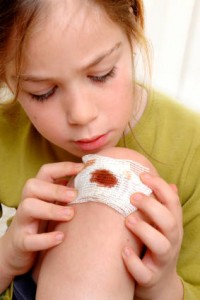
Anyone can sustain wounds by simply doing daily chores and activities. It is fairly common to see kids running around who end up tripping then falling on their knees and resulting to a few new scratches. Kitchen workers are likely to accidentally cut themselves while preparing meals, whereas athletes are more exposed to getting hit by other players and instruments while playing. These wounds are classified as superficial, causing damage to the outer layers of the skin. These wounds are the more common ones. The more uncommon wounds are the penetrating wounds which are more chronic and open, such as stab wounds, skin cuts, surgical wounds and gunshot wounds. Childcare first aid treatment also plays a vital role.
Usually, superficial wounds are external, non-penetrating wounds, which are mostly acute, as they heal faster and in a shorter period of time. These closed wounds are usually caused by dull trauma or friction with other surfaces, wherein the skin is not usually broken. Some types include abrasions, lacerations, and contusions. The most superficial and least severe is abrasion wherein there is a scraping of the outer layer of the skin, whereas lacerations are deeper and characterized by the tearing of soft body tissue. Contusions, more commonly known as bruises, are direct results of damaged or broken blood vessels caused by a blow to the skin.
Basic first aid training can be applied to these superficial wounds in order to clean the wound and reduce damage. It is important to apply basic first aid not only to prevent fluid and blood loss, but also to avoid the entry of germs in the body. Prior to cleaning a wound, one must first wash and dry their hands. If the wound is dirty, it should be cleaned under running water and then dried with a sterile dressing. The wound should be raised above the heart if possible. It should be covered and the immediate area cleaned with soap and water and patted dry. Antiseptic solution or ointment is a must to reduce the chances of acquiring infection. The wound should only be then covered with a sterile dressing or bandage.
If the wound is deeper and there is more bleeding, such as in lacerations, it is important to first apply direct pressure on the area in order to stop the bleeding. A health care provider should be contacted if the cut is located over a joint or if the person has not had a tetanus shot or booster within the last five to ten years. Several days after obtaining the injury, the bandage should be removed to in order to encourage healing. Check for signs of infection, some of which include pus, pain, foul-odor and mild swelling. If symptoms are observed, see a health care provider.
Take your time to watch this related video from YouTube about First Aid for Splints & Bleeding Wounds : How to Apply a Shoulder Sling
[media url=”http://www.youtube.com/watch?v=OJZGuGa8JEY” width=”600″ height=”400″]To treat contusions, the acronym PRICE must be recalled, which stands for protection, rest, ice, compression and elevation. The injured must be removed from the activity to prevent further trauma, allowed to rest, cool the injured area, compress and elevate to reduce damage to uninjured tissue.
There are several ways to learn proper treatment of wounded people. Particularly, several first aid and CPR courses are offered to lay people in time that emergencies may arise. Though often not very dangerous, minimal damage may be ensured with accurate treatment of wounds even the superficial ones.